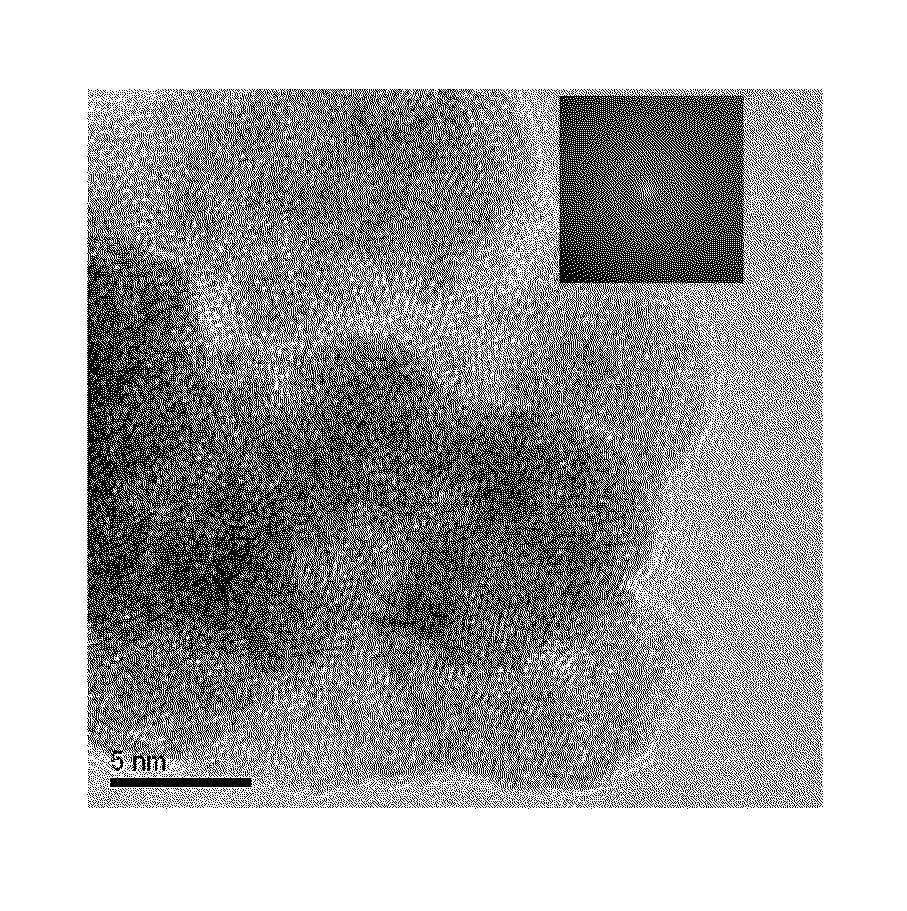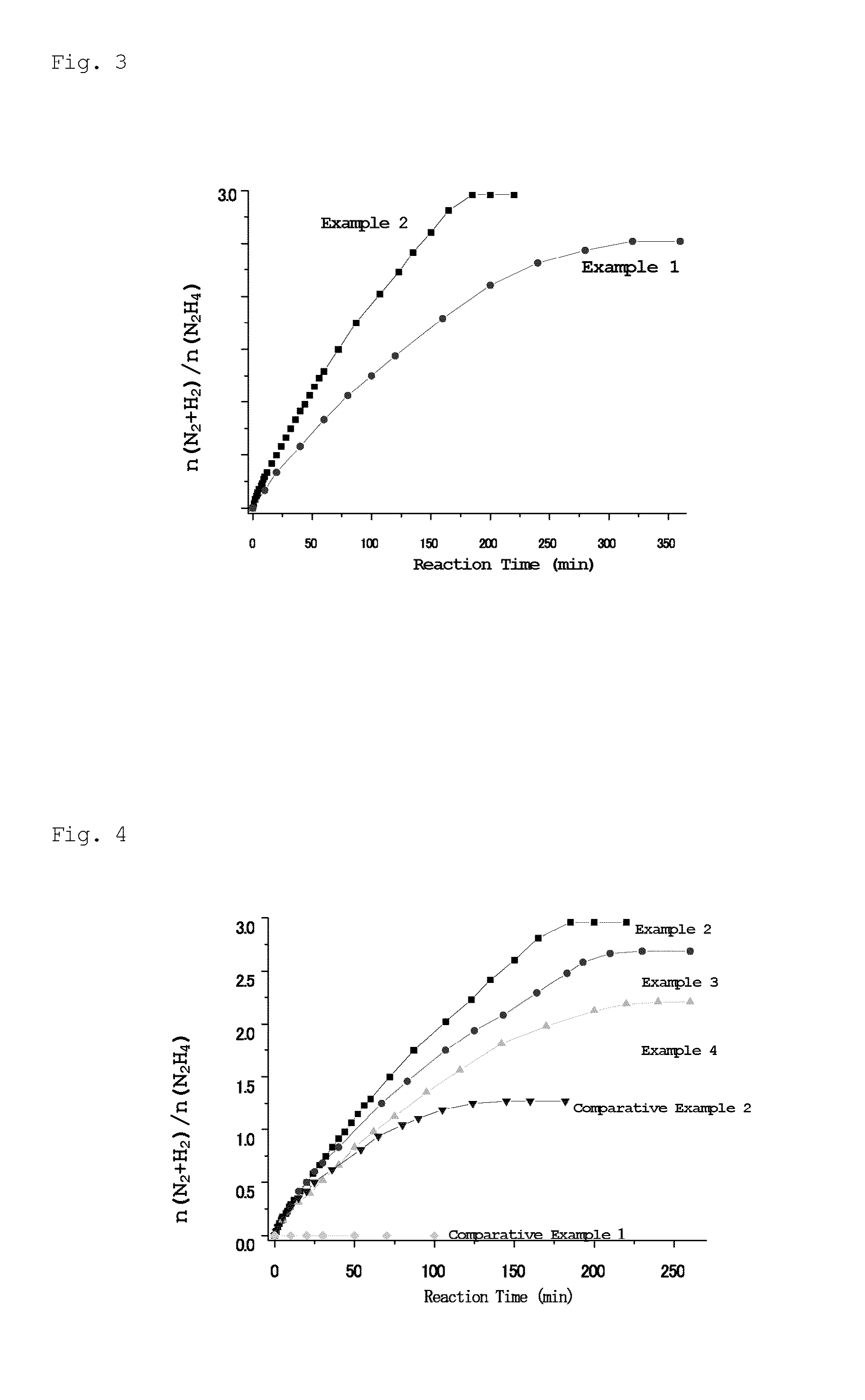Catalyst for generating hydrogen and method for generating hydrogen
a hydrogen and catalyst technology, applied in the direction of electrochemical generators, metal/metal-oxide/metal-hydroxide catalysts, physical/chemical process catalysts, etc., can solve the problems of large-scale equipment, large energy requirements for hydrogen generation, and large amount of hydrogen generated, etc., to achieve high selectivity and efficient generation
- Summary
- Abstract
- Description
- Claims
- Application Information
AI Technical Summary
Benefits of technology
Problems solved by technology
Method used
Image
Examples
example 1
[0072]NiCl2.6H2O (0.024 g), FeSO4.7H2O (0.028 g), hexadecyltrimethylammonium bromide (CTAB, 95%) (0.100 g), and water (2.5 mL) were placed in a 30-mL two-necked flask, and the mixture was ultrasonically stirred for 5 minutes, followed by heating at 50° C. for 5 minutes. An NaBH4 (0.010 g) aqueous solution (1.5 mL) was subsequently added, and the reactor was vigorously shaken for 5 minutes, thereby forming an NiFe nanoparticle catalyst.
[0073]A transmission electron microscope (TEM) image of the NiFe nanoparticle catalyst obtained is shown in FIG. 1. As is clear from FIG. 1, the catalyst was composed of ultrafine particles having a particle size of about 10 nm.
[0074]FIG. 2 shows a high-angle annular dark-field (scanning transmission electron microscope) (HAADF-STEM) image of the NiFe nanoparticle catalyst; it shows the EDS line scan spectral intensities of Fe and Ni measured along the line shown in the figure. It can be clearly seen from the EDS line scan spectra shown in FIG. 2 that ...
example 2
[0084]NiCl2.6H2O (0.024 g), FeSO4.7H2O (0.028 g), hexadecyltrimethylammonium bromide (CTAB, 95%) (0.100 g), and water (2.5 mL) were placed in a 30-mL two-necked flask, and the mixture was ultrasonically stirred for 5 minutes, followed by heating at 50° C. for 5 minutes. An NaBH4 (0.010 g) aqueous solution (1.5 mL) was subsequently added, and the reactor was vigorously shaken for 5 minutes, thereby forming an NiFe nanoparticle catalyst.
[0085]NaOH (0.080 g) was then added to the solution obtained above and the reactor was shaken to dissolve the NaOH. Hydrazine monohydrate (H2NNH2.H2O, 99%) (0.1 mL, 1.97 mmol) was added to the two-necked flask via a syringe, and stirring was continued at 70° C. Released gases were passed through a trap containing 1.0 M hydrochloric acid, where ammonia was absorbed; subsequently, only hydrogen and nitrogen were introduced into a gas burette, and the amount of the released gases was measured. After 10, 20, 32, 60, 107, 150, 185, and 220 minutes from the ...
example 3
[0089]NiCl2.6H2O (0.036 g), FeSO4.7H2O (0.014 g), hexadecyltrimethylammonium bromide (CTAB, 95%) (0.100 g), and water (2.5 mL) were placed in a 30-mL two-necked flask, and the mixture was ultrasonically stirred for 5 minutes, followed by heating at 50° C. for 5 minutes. An NaBH4 (0.010 g) aqueous solution (1.5 mL) was subsequently added, and the reactor was vigorously shaken for 5 minutes, thereby forming an Ni3Fe nanoparticle catalyst.
[0090]NaOH (0.080 g) was then added to the solution obtained above and the reactor was shaken to dissolve the NaOH. Hydrazine monohydrate (H2NNH2.H2O, 99%) (0.1 mL, 1.97 mmol) was added to the two-necked flask via a syringe, and stirring was continued at 70° C. Released gases were passed through a trap containing 1.0 M hydrochloric acid, where ammonia was absorbed; subsequently, only hydrogen and nitrogen were introduced into a gas burette, and the amount of the released gases was measured. After 5, 10, 20, 40, 83, 125, 164, and 193, 230, and 260 minu...
PUM
| Property | Measurement | Unit |
|---|---|---|
| particle size | aaaaa | aaaaa |
| temperature | aaaaa | aaaaa |
| temperature | aaaaa | aaaaa |
Abstract
Description
Claims
Application Information
 Login to View More
Login to View More - R&D
- Intellectual Property
- Life Sciences
- Materials
- Tech Scout
- Unparalleled Data Quality
- Higher Quality Content
- 60% Fewer Hallucinations
Browse by: Latest US Patents, China's latest patents, Technical Efficacy Thesaurus, Application Domain, Technology Topic, Popular Technical Reports.
© 2025 PatSnap. All rights reserved.Legal|Privacy policy|Modern Slavery Act Transparency Statement|Sitemap|About US| Contact US: help@patsnap.com



